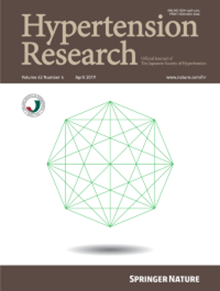Cross talk on therapeutic strategies: natriuretic peptides and inhibiting neprilysin in hypertension management
IF 4.3
2区 医学
Q1 PERIPHERAL VASCULAR DISEASE
引用次数: 0
Abstract
Hypertension, a prevalent cardiovascular condition globally, remains a significant public health concern due to its association with increased cardiovascular morbidity and mortality. Despite the availability of various antihypertensive therapies, achieving optimal blood pressure control in patients remains a challenge. Valsartan/sacubitril (ARNi), marketed as Entresto by Novartis, combines valsartan, an angiotensin receptor blocker, with sacubitril, an inhibitor of neprilysin. Neprilysin is responsible for breaking down natriuretic peptides and other vasoactive substances. Inhibiting neprilysin prevents the degradation of natriuretic peptides, enhancing their beneficial effects on blood pressure regulation. Natriuretic Peptides, including atrial natriuretic peptide (ANP) and brain natriuretic peptides (BNP), play pivotal roles in regulating blood pressure and cardiovascular homeostasis by promoting vasodilation, natriuresis, and antagonizing the renin-angiotensin-aldosterone system. Therefore, this combo drug lessens sensitivity to natriuretic peptides and tackles the processes in hypertension that activate the renin-angiotensin-aldosterone system. This review provides an overview of how natriuretic peptides (NPs) contribute to blood pressure regulation for the treatment of hypertension through inhibiting neprilysin. It highlights the ARNi''s dual action that works synergistically by blocking the harmful effects of angiotensin II on blood vessels while simultaneously increasing the levels of beneficial natriuretic peptides. Schematic representation of the mechanism of action of ARNi. Abbreviation: -Renin angiotensin aldosterone system (RAAS), Natriuretic peptides (NP), Atrial Natriuretic peptide (ANP), Brain natriuretic peptide (BNP), C-type natriuretic peptide (CNP), Angiotensin II (Ang II), Angiotensin receptor neprilysin inhibitor (ARNI).

治疗策略的交叉对话:高血压治疗中的利钠肽和抑制肾酶。
高血压是全球普遍存在的心血管疾病,由于其与心血管疾病发病率和死亡率的增加有关,因此仍然是一个重大的公共卫生问题。尽管目前有多种降压疗法,但要使患者的血压得到最佳控制仍是一项挑战。缬沙坦/萨库比特利(ARNi)由诺华公司作为 Entresto 上市销售,它将血管紧张素受体阻滞剂缬沙坦与肾小球酶抑制剂萨库比特利结合在一起。肾小球酶负责分解钠尿肽和其他血管活性物质。抑制肾酶可防止钠尿肽降解,增强其对血压调节的有益作用。包括心房利钠肽(ANP)和脑利钠肽(BNP)在内的利钠肽通过促进血管扩张、利尿和拮抗肾素-血管紧张素-醛固酮系统,在调节血压和心血管稳态方面发挥着关键作用。因此,这种复合药物可降低对钠利尿肽的敏感性,并解决高血压中激活肾素-血管紧张素-醛固酮系统的过程。这篇综述概述了利钠肽(NPs)如何通过抑制肾素酶来促进血压调节,从而治疗高血压。它强调了 ARNi 的双重作用,即通过阻断血管紧张素 II 对血管的有害影响,同时提高有益的钠尿肽水平,从而发挥协同作用。ARNi 作用机制示意图。缩写:肾素血管紧张素醛固酮系统 (RAAS)、钠尿肽 (NP)、心房钠尿肽 (ANP)、脑钠尿肽 (BNP)、C 型钠尿肽 (CNP)、血管紧张素 II (Ang II)、血管紧张素受体肾素抑制剂 (ARNI)。
本文章由计算机程序翻译,如有差异,请以英文原文为准。
求助全文
约1分钟内获得全文
求助全文
来源期刊

Hypertension Research
医学-外周血管病
CiteScore
7.40
自引率
16.70%
发文量
249
审稿时长
3-8 weeks
期刊介绍:
Hypertension Research is the official publication of the Japanese Society of Hypertension. The journal publishes papers reporting original clinical and experimental research that contribute to the advancement of knowledge in the field of hypertension and related cardiovascular diseases. The journal publishes Review Articles, Articles, Correspondence and Comments.
 求助内容:
求助内容: 应助结果提醒方式:
应助结果提醒方式:


